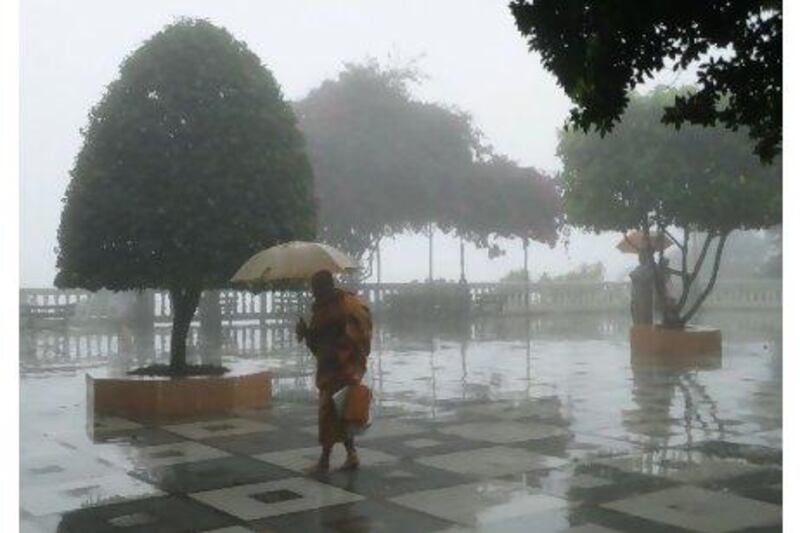The mist parts, revealing a canopy of primordial green deep in the mountains of Chiang Mai in northern Thailand. Above, shades of grey coat hanging vines and trees that arch over the motorway. This is a moment of sublime freedom - nothing but unending road, the stillness of the forest, and the wild buzz of cicadas as I coax the rented motorbike up the steep curve of the mountainside.
As I rise, the bliss slowly fades, replaced by mild apprehension as the heavy clouds that have hovered over the city throughout the morning finally break, sending sheets of rain sluicing over a very smooth, and very steep, mountain road.
Thank God for ponchos and rail guards I think, revving the throttle and hoping the Honda has enough traction to carry me the 1,200 metres to the top.
And all this for what? A wat. A what? A wat - one of the thousands of temples that dot the landscape of Thailand, that abound on every street and alleyway, and that usually don't require an 18-kilometre trek into the hills. But this particular wat, Doi Suthep, is lodged deep in the mountains outside of Chiang Mai city, and is particularly sacred as it is said to house a relic of Buddha in its gilded stupa.
But as cold rain seeps into my clothes, in between my hands and the handlebars, into my bag, and through the keffiyeh that guards my face, what began as curiosity and an ineluctable desire to see lots of shiny things in Asia quickly plummets into regret.
As I reach the summit, I sigh. Rain cascades down the steps to the temple in small waterfalls of impenetrability. The road back looks like a churning brown mudslide. And my friend Patty, ambivalent about scootering up the mountainside after witnessing my driving in the UAE, is still chugging along below me in public transportation.
So I find the only tea stall along the road - a table with two stools and a leaky umbrella - and crouch underneath it, shelling out a small fortune for half cups of cocoa in the hopes of claiming a permanent space at the wooden block that serves as a counter.
"This cocoa from Belgium," the gap-toothed owner of the stall says, proudly, tapping a Van Houten tin on my fourth round - assuring me that here, in a row of food shacks across from a site of national veneration, I'm not getting shrifted. Thank you, I say, and pay the cost of a one-hour massage for a half cup of imported cocoa powder.
I am relieved of a life under blue tarp when Patty arrives at last, and together we brave the wat. Once inside, it is holy ground, of course - no shoes, so the horde of unfortunate visitors that have picked this day to tour find themselves slapping around on cold marble in ankle-deep water, ducking under awnings lined with gold Buddhas and taking shelter inside damp temples.
The gilded surroundings, as usual, enchant me, as I maintain an insufferable Mediterranean attraction to anything gold. And what sources of endless fascination Doi Suthep provides - from the towering, golden Buddhas to the glimmering mosaics of gold, emerald and sapphire, to the gold stupa in the centre that stretches towards the sky in auric brilliance.
The design reminds me of the three temples in Wat Phra Kao on the grounds of the Grand Palace in Bangkok, which are gold structures embellished with golden accents and surrounded by golden statues. A dehydrated and tired Patty eventually peeled me off of the wall after hours spent hugging their sides.
At Doi Suthep, I can't help but notice how odd we look - a gaggle of foreigners in pink and green and blue plastic, armed with photo lenses and umbrellas and maps, slogging through an ancient backdrop that seems a scene out of Buddhist scripture.
Around us, chimes lining the triangular temples ring in sweet, clear notes, and the trees seem to breathe in the rain, wrapping mist around them like a thick, protective cloak. A monk in saffron robes and flip-flops glides across the marble parquet, fighting the wind with a collapsed umbrella, and the cloying smell of incense hangs in the air.
Inside one temple, a monk blesses visitors with holy water, chants and prayer strings. The offerings next to him are known colloquially as "monk packs" - gifts of everything from dishwashing detergent to food in the hopes of greater blessings.
Another low, crouching temple houses the Thai version of Kau Cim, or fortune-telling sticks, which can answer prayers a supplicant may have. Begun in China and carried on by Tibetan tradition, the sticks are shaken from a bamboo cup after a prayer is made on a particular matter. One stick usually shakes out; the number on it corresponds to a written fortune that is written on a pamphlet next to the altar.
The answers Patty and I receive are sufficiently vague and well-meaning enough to have us walk away satisfied. But as we slosh back down to the main entrance, the sky momentarily ceasing its punishment, the only prayer I have is one of survival. Will the blessings of Doi Suthep in all its golden glory be enough to protect me from 18 kilometres of downhill tarmac?
Next week: Thailand, Part II. Follow Michelle's adventures at Around Asia.





